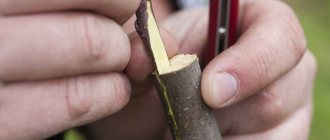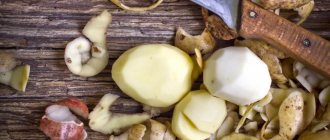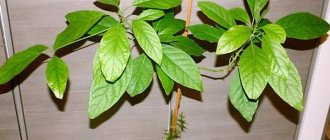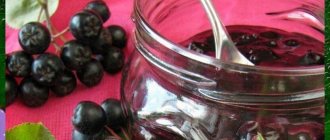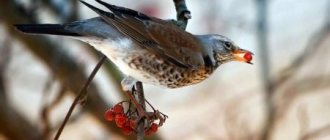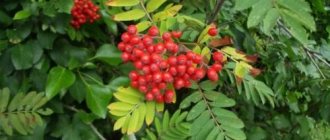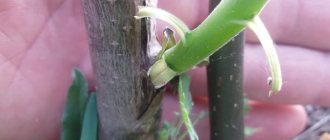Why is rowan grafting needed?
Grafting pear onto rowan
Many gardeners, when thinking about grafting, for example, a pear onto an apple tree, get confused in their heads. An apple tree is an apple tree, and a pear tree is a pear. Why combine them into one tree? However, in fact, this procedure has a huge number of advantages, which many, unfortunately, often do not notice.
Let's say you have a very fancy plant, the cultivation of which takes a lot of time and effort. In this case, you can very well graft it onto something else. Thus, the rootstock plant (the name of the mother plant on which the graft is made) will share its strengths with the scion plant (the plant that is grafted onto the mother plant).
What is it for?
With this technique, the scion plant is planted on the mother tree. The rootstock, as it were, shares its capabilities with a seedling that is more whimsical and demanding of growing conditions. The method is based on the plant restoring its trunk and branches due to the middle layer of wood - cambium, therefore, cuts of the scion and rootstock must be of the appropriate depth, otherwise fusion will not occur, while the rootstock and scion form one organism with a single metabolic system.
Benefits of vaccination:
- growing a strong varietal plant with the desired characteristics in conditions that are not very suitable for it, for example, when replanting a cultivated apple tree with a wild one;
- the ability to place a large number of varieties in a limited area and implement interesting design ideas, for example, miracle lilac with a variety of flowers on one trunk;
- quick replacement of a variety you don’t like with another;
- obtaining fruits several years earlier than with other growing methods;
- the possibility of restoring a damaged plant (for this, bridge grafting is most often used, covering the site of damage);
- obtaining a tree or bush of a more compact shape.
What are the benefits of vaccination
Grafting pear onto rowan
No matter how strange and unnatural this procedure may seem, it provides both the scion plant and the rootstock with many advantages that they could not obtain in any other way.
These advantages include:
- Obtaining the desired varietal qualities from a hybrid plant, taking into account the fact that it grows in conditions that are not the most suitable for it. For example, a cold-resistant plant can easily shelter a non-winter-hardy plant on its branches and provide it with protection during the winter cold.
- Saving site space. Most gardeners have far from unlimited territory, and therefore the issue of free space is extremely pressing. I would like to have as many plants and their varieties as possible, but at the same time not burden myself with daily care of several hectares of plantings. In such a situation, vaccinations come to the rescue because they allow you to fit, roughly speaking, several plants at once in the place of one.
- If you suddenly don’t like the plant variety you bought, using grafting you can almost painlessly replace it with another quickly and without even digging up the first plant.
- Using the grafting method, you, roughly speaking, grow a full-fledged plant, but you spend many times less time and resources on it than you could in any other scenario. And this also means that you will receive the fruits not in a few years, but already, for example, in the next season.
- Restoring a plant that has received significant damage during its life is also a rather useful function of grafting. Plus, not only do you get a healthy plant at the end of the operation, but you also get two plants instead of one.
- What gardener would not want a plant to grow exclusively where he points it to? However, with the help of vaccinations, such a trick can be accomplished.
- More efficient propagation of varietal and hybrid plants. Unfortunately, propagating them by seeds is extremely thankless and useless work, because after a couple of generations all the special qualities of the variety will be lost forever. However, grafting allows hybrids to be endlessly propagated without losing their characteristics.
Tree with different varieties
If only a small area is allocated for the garden, but you want to grow different varieties of crops, then try placing them on one plant. Such a “family” tree is best obtained from an apple tree.
As a rootstock, select a winter apple tree and graft 2-3 varieties onto it with different ripening periods. This way you can enjoy fresh fruits throughout the season.
Grafting should be done only on young trees and specifically on skeletal branches closer to the trunk. Otherwise, the tissues on the rootstock and scion will not grow together.
If you want to surprise your relatives and neighbors, try grafting a pear onto an apple tree. It will be easier to collect fruits from this plant, since apple trees tend to grow shorter than pears. But it’s unlikely to be possible to do the opposite: an apple tree takes root very poorly on a pear tree.
You can also try to graft several varieties of pear onto the crown of a varietal rowan. This way you will get a very unusual and winter-hardy tree.
Pears of the Cathedral, Lada, Martovskaya, Moskvichka, Pamyati Yakovleva, and Chizhovskaya varieties take root well on mountain ash.
Experimental gardeners graft pear trees onto hawthorn, serviceberry and even chokeberry. The pear fruits on them have excellent taste and large size, but such trees are short-lived: they live only up to 8 years. Therefore, every year in the spring it is recommended to plant 2-3 new cuttings to replace aging shoots.
Saskatoon and chokeberry are capable of growing in areas with close groundwater, so grafting onto these trees helps to grow pears in conditions unsuitable for them.
In the spring (usually in the second half of April), the pear is grafted using improved copulation methods, in a T-shaped incision or in a split. And in the summer you can also vaccinate with the eye.
Why was rowan grafting chosen?
According to most experts, rowan is the most suitable tree for growing other plants. The fact is that rowan can grow on almost any soil: both swampy and acidic, and absolutely neutral.
It has a very convenient and compact crown shape. Let’s not forget that rowan is an incredibly frost-resistant plant. With good care, it can withstand more than 50 degrees below zero. In addition, it is the mountain ash that has a huge number of family ties with many fruit trees. Everything that was written above makes rowan one of the most suitable candidates for the role of rootstock for almost any scion.
Rowan grafting: which types are most suitable
That’s right, there are also a huge number of types of vaccinations, and which one to choose is, for the most part, a matter of taste. However, rowan prefers certain types of them, the list of which is headed by split and side cut grafting.
Perhaps it is worth talking in more detail about the first of these two options, since it is the simplest of all existing ones.
This grafting method involves, as you might guess, splitting (splitting) the trunk of the rootstock. The selected scion cutting is inserted into the resulting crack. In fact, it's as simple as it sounds. This process is especially simplified by the fact that it does not require any additional knowledge or preparatory work from the gardener. Everything you need to know to perform a successful operation, you most likely already know.
The only thing you need to watch very carefully is cutting cuttings. They must protrude slightly above the level of the cleft. It is equally important to cover the surgical site with garden varnish, since it is very vulnerable to bacteria, infections and fungi. But wrapping the tree, unlike many other methods, is not at all necessary. Although, to be sure of success, this can still be done.
Caring for the grafted tree is no less important. It is especially necessary in the first weeks, so try to provide both the scion and the rootstock with good shading.
When examining the second method of grafting, it should be noted that, in principle, it is also quite easy to learn, and you do not need any advanced skills in gardening. the cutting you like from the mother plant of the scion.
The cut should be quite long: at least two and a half times the diameter of the scion cutting itself. After we have received a cutting with a cut on one side, it is necessary to cut it on the other, thus forming a wedge. On the rootstock you need to make a small but deep cut in the shape of the letter “T”. Then the edges are moved to the side and a previously prepared scion cutting is inserted into them.
When carrying out this operation, it is imperative to wrap everything with twine or a grafting tape specially created for such purposes. In order to monitor how successfully the vaccination went, you will have to wait two to three weeks. Only after this period it will be clear whether the scion has taken root on the rootstock or not.
If the bark begins to thicken at the grafting site, this means that something went wrong and the experiment can be repeated. If rejection is not observed, then after four to five weeks the wrapping applied to the grafting site can be removed, and after seven weeks the success of the operation will become completely clear.
In addition, it is important to keep an eye on the branches. They need to be cut, but not all of them, since they protect the scion well from drafts.
What can hawthorn be grafted onto?
Hawthorn can be grafted onto red rowan and onto old, non-fruitful hawthorn bushes. The best rootstock for hawthorn is considered to be red rowan. Reproduction in this way makes it possible to obtain a standard tree, on which, as practice shows, the taste and medicinal qualities of the fruit do not change.
When grafted onto an old bush, the bush is rejuvenated and fruiting resumes.
Grafting hawthorn onto an apple tree
Closely related plants can be grafted onto an apple tree. That is, an apple tree with an apple tree or an apple tree with a pear can be propagated by grafting.
The main condition for any grafting is that only stone fruits take root on stone-type specimens, and pome-shaped specimens take root on pome-bearing specimens.
When interspecific trees propagate, the plant will be short-lived, with a small and poor-quality harvest.
Is it possible to graft hawthorn onto a pear seedling?
You cannot graft a hawthorn onto a pear; you can graft certain varieties of pear onto a hawthorn. When doing experimental grafting, it is necessary to remember that when propagated in this way, fruiting occurs in 2–3 years. Therefore, when grafting specimens of different breeds, you can lose a lot of time and not get the expected result.
Timing and rules of vaccination
Hawthorn can be propagated by grafting after the snow melts, before the buds open, or immediately after the leaves fall. For the scion, take 2 summer plants with a root collar diameter of 1 cm. The grafting is carried out at a height of 1 m, and the side shoots are not removed.
The key to good survival depends on cuttings. They should be:
- cut from the south side of the tree;
- prepared in the fall and overwintered in the cellar or refrigerator;
- they should have from 4 to 7 well-developed buds.
Advice! Since hawthorn has very dense bark, grafting is carried out with a sharp instrument.
Whatever vaccination method is chosen, the technique is the same for everyone:
- The grafting site is tied with polyethylene or insulating tape.
- Open areas are treated with garden varnish.
- The joints must be protected from moisture penetration, but not overtightened.
- A month after the kidneys appear, the bandage is loosened.
- Until complete growth, the hawthorn needs care and attention: protection from direct sunlight, removal of excess branches, prevention of insect pests.
The success of the work will be visible in 30–40 days. If propagation is carried out according to the rules, and the scion quickly takes root, the hawthorn will begin to bear fruit the next year.
What can be grafted onto hawthorn
Hawthorn is an excellent rootstock for pears. The seedlings grafted on it develop well and bear fruit. In order for a fruit tree to begin bearing fruit, it is necessary to choose the right varieties. The following varieties reproduce well on hawthorn: Talgar beauty, Zolotovorotskaya, Prikarpatskaya, Bere Kyiv, Goverla. They give good growth, begin to immediately form flower buds and bear fruit.
Some varieties, according to gardeners, do not take root on hawthorn. These include: Sonatina, seedless Dricha, 56-25 Vyzhnitsa.
When is rowan grafting done?
Typically, rowan grafting, like almost any other gardening operation, is performed in the spring, since this is the most optimal season. The best time for vaccinations in biological terms is the beginning of the period of juice movement. This means that scion cuttings must be prepared even earlier: two weeks before the operation itself. After cutting, they must be stored in a cool place.
Important! It is highly undesirable to graft on a rootstock younger than two years old.
On the other hand, many vaccinations carried out in the summer and even in the fall also turn out to be successful. Let's say more: even in winter, a cutting can be grafted onto a rowan tree. However, it is worth noting that in all these cases the survival rate drops significantly compared to procedures carried out in the spring.
Therefore, if you really want to try the vaccine, and spring has just passed, you can try your luck in the summer season. However, if possible, try to meet the spring deadlines.
Grafting pear onto rowan
Grafting pear onto rowan
The first plants to be grafted onto rowan were pears. This experiment was carried out to increase their fruiting in the middle zone, where they showed, frankly speaking, not the most champion results.
Unfortunately, not all varieties turned out to be well compatible with the rootstock. It also happened that some varieties froze to death during the first cold of winter. However, those with whom the operation was carried out successfully showed very good results in the future.
There is an opinion that all these well-grafted varieties descended from one common ancestor - the Ussuri pear. It is these varieties that can be used to graft onto rowan and other, less compatible ones. This works because during the year that the compatible variety spends on the mountain ash, it will have time to “get used” to the pears and will be able to allow even the least compatible varieties to grow on itself.
It is quite possible to search for a rootstock even in the forest. Most often, the most compatible rowan trees will grow next to coniferous trees: spruce and pine. If the choice is large, you should give preference to the tree whose diameter will not exceed three centimeters (one meter from the ground level).
After digging up a rowan tree, the surest action is to wrap the root in a bag (for better preservation). As already mentioned, the best methods of grafting onto such a rootstock are grafting rowan into a split and grafting rowan into a side cut.
However, a pear grafted onto a rowan tree has one serious problem: the pear grows and develops much faster than the rootstock. Therefore, in the near future its branches will be much thicker than those of the mountain ash itself. Because of this, an extremely unpleasant situation can occur: the crown of the tree will be so large and massive that the trunk simply cannot support it.
In order to avoid this unpleasant situation, you should:
- Use support. This is the simplest and at the same time the most reliable method of all. The support will, in fact, be a second trunk, which will prevent the scion from collapsing.
- The second method is much more complicated, and therefore it would be much preferable to choose the first. However, if you want, you can plant a few more small mountain ash trees next to the rootstock and combine all their trunks, thus creating a strong structure.
When grafting, there is one more very important rule: it is advisable to remove the branches of the rootstock. The fact is that otherwise the rowan branches will dominate and suppress the pear. However, this does not mean that there should be no rowan left on the rowan tree.
At least 25 percent of all branches must belong to the mother plant, since only they can produce exactly the photosynthetic products that the rootstock needs. Let's not forget about watering. In the end, rowan, although not a particularly fastidious plant, consumes a huge amount of water.
Therefore, especially if the season is dry, the plant on which the graft was made must simply be watered as abundantly as possible. If you don’t do this, you risk getting a much less juicy, abundant and high-quality harvest than you expected.
And in order not to waste excessive amounts of water on watering, we suggest you mulch. This is not a mandatory procedure, but it is incredibly useful. In addition to preserving moisture, which is its primary task, it also does a good job of fighting weeds.
Useful videos
In this video - grafting an apple tree onto a rowan tree. Growing apple trees in the North:
See the agronomist's advice on how to vaccinate an apple tree:
Video instructions on how to graft an apple tree into a split:
Watch the video on how to properly care for apple tree grafts:
Grafting an apple tree onto a rowan tree is a necessary and interesting task. The result of successful experiments is a rich garden, pleasing with diversity.
Each successfully grafted twig is an irreplaceable experience for the gardener. And the main thing is to have patience, you can’t have enough of it in this difficult field.
Why do we vaccinate? Of course, to improve some characteristics of the trees already growing in our garden. This particular plant is used quite often as a rootstock, and even the most novice gardeners can quite successfully master this science. The raw materials are available, very cheap and take root well in almost any conditions. Why is this not an ideal solution for vaccination? Let's figure out what can be grafted and which tandem with rowan will be the most successful in practice.
What ornamental and fruit can be grafted onto rowan?
To make it easier to navigate this topic, we will divide all possible scion options into several groups:
Every gardener, like all passionate people, dreams of creating something new and interesting in their field - growing an exotic plant, the most beautiful flower, the largest and most delicious fruit. This will be helped not only by careful care and selection (breeding new varieties), but also by vaccinations.
Grafting apple trees and other plants onto rowan
Grafting an apple tree onto rowan
Naturally, pear is not the only tree that can be grafted onto rowan. At a minimum, its closest relative - the apple tree - should have a fairly high survival rate on mountain ash, right? Yes, this is true, but only if you choose the right variety. For example, the plum-leaved apple tree shows very good survival rate.
Well, of course, who, if not another variety of rowan itself, could be the best candidate for rowan scion? However, in addition to itself, chokeberry is well grafted onto rowan, which after grafting forms a very compact and beautiful bush, without losing its taste.
You can also list shadberry or dogwood as good plants for scioning. Also, everyone’s favorite hawthorn shows extremely good results when grafted onto rowan. After the procedure, it, just like chokeberry, forms an extremely compact, convenient and beautiful bush.
But such crops as, for example, plum or cherry, do not show a positive result when grafted onto rowan. Their problem is that these plants do not tolerate stagnant moisture at all, which, on the contrary, rowan loves.
So any attempt to graft one of these plants onto her will either end in failure or with noticeably less impressive results than you might expect.
What else can be imparted?
It is also possible to graft an apple tree onto a rowan tree, but you should select varieties that come from the plum-leaved apple tree (Kitaika). In this case the compatibility is quite good.
Black rowan (chokeberry) has good survival rate with red rowan. Chokeberry grows strongly, and after grafting a compact bush is obtained, the taste and quality of the fruit are not lost. For serviceberry and dogwood, rowan as a rootstock is also very suitable.
Everyone knows hawthorn as an ornamental crop. The rowan scion turns out to be compact and grows less, as is the case with chokeberry.
Due to close groundwater, in many areas it can be difficult to grow cherries and plums, which are sensitive to stagnant moisture in the soil. Of course, they tried to graft them onto mountain ash. But experiments have shown that compatibility here is poor. There is a way out - regrafting through cultivated varieties of the rootstock.
- the introduction of pathogenic microorganisms due to insufficient cleanliness during the grafting process, which will inhibit the growth and development of the scion;
- the time or weather for grafting was chosen incorrectly, the cutting could have been overdried from the heat or frozen, a strong wind also does not contribute to a good result;
- inappropriate vaccination method;
The use of rowan as a scion is not new for gardeners, but ignorance or ignoring some of the nuances sometimes becomes a hindrance. In the article we will tell you how to graft rowan, consider the methods used and their features.
Rowan grafting has a number of positive results for both the gardener and the plants:
- the first harvest appears several years earlier than when planted by cuttings or seeds;
- experiments with varieties are not difficult, and it takes less time to search for the desired variety (one or two cuttings are enough) and wait for the result;
- when grafting different varieties of plants, an exclusive garden design is obtained;
- more space for new trees and beginnings because two or more species fit on one trunk;
- if you want to change a variety you don’t like, the process will not become a burden and will not take much time;
- the use of grafting cuttings from a tree that is in danger of death to a healthy one claims to be successful;
- grafting brings into the garden varieties that are not able to take root in the climatic conditions of the area when grown independently. Acquiring vaccination skills requires knowledge and experience, as well as a desire to try new things.
Rowan grafting: some tips for gardeners
Grafting lemon onto rowan
Unfortunately, many gardeners often give up the idea of grafting because the procedure cannot be successful. It would seem that you have followed all the specified recommendations and carefully read all the instructions, but the result is still extremely negative.
This can happen for many reasons, so we will try to prevent, if not all, then most of them.
- First of all, it is very important to ensure that the operation is carried out cleanly. After all, we are working with a bare cambium, and it’s easy to introduce some kind of infection into it.
- Many also greatly underestimate the importance of choosing the right time for vaccination. But in a sense, well-chosen timing is already half the success of the procedure. Weather conditions are no less important. For example, strong winds and hot sun can obviously ruin your vaccination results.
- Choosing a grafting method that is not suitable for your plant can also be fatal.
- If the cut sizes of the scion and rootstock are too different, it may happen that, no matter how compatible the plants are, they simply will not grow together.
- It is also important to choose good grafting tools. For example, a poorly sharpened knife can leave large nicks on the cuts, which will not contribute to grafting in any way, but on the contrary, slow it down or make grafting impossible.
- Protracted vaccination. If you do not carry out all the work quickly, the surface of the cuts will begin to oxidize, and this risks the fact that the rootstock and scion will not take root. The better you prepare and the faster you complete the procedure, the better the result will be.
- Folding the scion and rootstock is not according to the rules. It would seem that this is a trifle, but this trifle can lead not only to vaccine rejection, but also to rot.
- The harness is too weak. It also does not promote fusion at all. It will be much better if, when vaccinating, you tighten it tightly, and after a while, having discovered the consequences of a tight tie, loosen the tape.
Berry bushes on a trunk
Such unusual berry trees attract the attention of even those people who are indifferent to any plants. Most often in gardens you can find standard chokeberry (up to 3 m high), but standard forms of gooseberries and currants look more exotic. This effect can only be achieved through grafting, since shaping does not bring the desired results due to the abundant growth and fragility of the branches.
These small trees not only bear fruit well, but also look very decorative. They ripen large, clean and juicy berries.
It is recommended to graft gooseberries and currants onto a 2-3-year-old golden currant seedling. You can buy it at a specialized nursery or grow it yourself from seeds that are sown in the fall. Grafting should be done in the spring with cuttings prepared in the fall and the method of improved copulation should be used for this.




